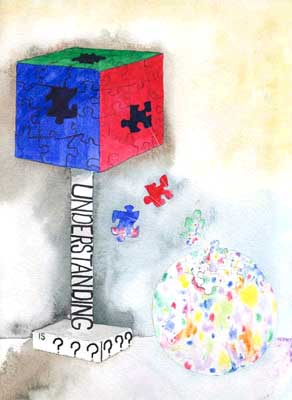|
 Serendip's 10th Anniversary: An Invitation to an Intellectual Playground Serendip's 10th Anniversary: An Invitation to an Intellectual Playground
by Ann Dixon, Bryn Mawr '83, Serendip Co-Founder and Webmaster
What do a neurobiologist, a businessperson, a computer scientist, a psychologist, an artist, an English professor, a social worker, a physicist, a philosopher and a chemist have in common with you? Welcome to Serendip, an intellectual community and website open to the world which encourages conversations, teaching and learning across traditional disciplinary and academic/non-academic boundaries in exploratory, serendipitous ways.
| Learning is Fun and Interactive
If you spend an hour with a young child, you see the world through her eyes, a world where everything is new for discovery and play. More than anything else, you see that learning is fun, lots of fun.
Serendip works from the premise that learning and thinking are something that you do, not something that is done to or for you. Because pursuing your personal engagement with an interesting topic is the best and most exciting kind of learning, whatever your age, Serendip offers several different forms of exploration for you to pursue: interactive experiences, interactive discussions, and interactive authoring. |
Facts about Serendip:
Born in 1994
First website on campus
Hosted the Bryn Mawr College website, c. 1995-96
Hosted the College Library's first website
Over 3 million unique visitors in 2006
More than 20,000 pages
Averages more than 20,000 unique visitors per day
More than 99% of its visitors are from off-campus
Home of Center for Science in Society
Hosted College Diversity Conversations, c. 2004-06
Most popular exhibit:
Mind and Body: Rene Descartes to William James
translated into Spanish and Russian
Recent exhibits:
Serendip's Exchange
Exploring Emergence: The World of Langton’s Ant
Education and
Technology: Serendip's
Experiences 1994-2004
|
Interactive Experiences
Serendip's "Playground" section is a starting point for these different interactive educational experiences. Each experience is described by a question, such as "Does your brain make up stories?" or "Does an ordered system require a planner?" or "What happens if people cluster with others with similar characteristics?” To join in the fun, go to the Playground section ( http://serendipstudio.org/playground) and click on one of the interactive experiences to begin discovering answers to these sorts of questions for yourself.
 The interactive exhibit, "Thinking about Segregation and Integration", is one of the more recent additions which explores why people cluster with others with similar characteristics to themselves. Some of the results may surprise you. Besides the specific questions that are raised about social attitudes and preferences, working with the exhibit offers the real experience of developing and working with a model to answer questions and ask new ones. A related interactive exhibit, "Time to Think?", offers background support of real opportunities to do your own research, while exploring the question of whether all aspects of human behavior and experience are “contained” within the brain (with gratitude to Emily Dickinson). The interactive exhibit, "Thinking about Segregation and Integration", is one of the more recent additions which explores why people cluster with others with similar characteristics to themselves. Some of the results may surprise you. Besides the specific questions that are raised about social attitudes and preferences, working with the exhibit offers the real experience of developing and working with a model to answer questions and ask new ones. A related interactive exhibit, "Time to Think?", offers background support of real opportunities to do your own research, while exploring the question of whether all aspects of human behavior and experience are “contained” within the brain (with gratitude to Emily Dickinson).
Interactive Discussions
While interactive exhibits on Serendip offer individual opportunities for questioning and learning, the online conversations in the forums give you the opportunity to learn by thinking together in groups. The forums are a place where the not-fully-formed idea or opinion is welcomed, even encouraged, as a way to access unconscious thoughts, the raw, underlying material of intellectual engagement. Undergraduate courses, like Neurobiology and Behavior or Big Books of American Literature, use the forums to supplement class discussions, and groups with a common interest, such as Emergent Systems or Grad Idea, to further inquiry. Other forums seek to discuss sometimes painful issues online, like Diversity Conversations, Relativism and Fundamentalism, and the September 11th and Place of the US in the World Community forums.
Still other forums take an online Serendip exhibit to new places. Paul Grobstein, Eleanor A. Bliss Professor of Biology and co-founder of Serendip, intentionally uses the "I am, and I think, therefore..." forum to engage people from a variety of disciplines and to demonstrate the value of shared storytelling as a means to learn. The forum participants discuss the central question of the "Writing Descartes" exhibit: Is "thinking" a solid foundation? Or as ephemeral as everything else? Or something else entirely?
Forums are used regularly to enhance undergraduate course in-class discussions, and often engage students who might not easily talk in the classroom. Whether or not you talked in class when you were a student, the professors on Serendip welcome alumnae “drop-ins” to course online discussions. You bring a different perspective and assumptions to readings and films, can challenge current students’ thinking and be challenged in return. To see what the current course offerings are on Serendip, click on the “Undergraduate Courses” link on Serendip’s home page; forums are linked from each course’s home page. To find a list of all the forums on Serendip, click on the Forums link from Serendip’s home page.
Interactive Authoring
In selected courses, students are asked to write “web papers,” papers in lieu of tests and exams which incorporate online research, and to “publish” them on Serendip. Like other materials on Serendip, this process is meant to change and challenge both the reader and the writer.
For Serendip’s readers, the web papers provide a jumping off point for further inquiries into (often scientific) topics which may have an extensive technical literature but not necessarily an accessible treatment. The web papers are hugely popular with Serendip’s readers, who often find them through search engines like Google. If you type “sleep deprivation” into Google, for instance, you will find that one of the top 10 listings is a web paper written by a neurobiology student and posted on Serendip in 2001. Trust a Mawrter to know something about sleep deprivation!
For Bryn Mawr undergraduates who are Serendip’s writers, the web papers provide the perspective and opportunity to write for a large audience. This takes some getting used to. Unlike those papers written for a professor who grades and gives you comments in private and then you’re “finished,” these papers are literally read by thousands of people, even many years later. They can be read by other students in the course (and often are), students in future offerings of the course, friends, family, future employers, and of course, total strangers around the world. While this pressure doesn’t seem to cause greater writer’s block among our intrepid students, it might affect the quality and topic selection of their writing. Mind your run-on sentences and comma splices.
A new feature on Serendip this year is to incorporate selected reader comments on the web papers themselves. Factual corrections, recounting of personal experiences related to the topic, and updates to the research at the time the paper was written are examples of how the “Serendip Readers Write Back” feature expands the conversation. For Serendip, the act of reading is never passive, and if that active engagement can be captured and shared with other readers, then we are actively modeling shared storytelling as a vibrant learning environment.
Of course, not all materials on Serendip are written by students in courses. Much of Serendip’s continually expanding content consists of contributions by faculty and others, at Bryn Mawr and worldwide, including alums. So, if you'd like to contribute, email me or Paul Grobstein (pgrobste@brynmawr.edu) or click on “Join Us” in the Serendip menu bar.
Learning has No Boundaries
 There are good reasons to categorize knowledge by disciplines and to systematize teaching research methods by disciplines in schools. It is only recently that the value of interdisciplinary study, research and groups has been recognized in colleges and universities (cf “Theorizing Interdisciplinarity: The Evolution of New Academic and Intellectual Communities,” by Dalke, Grobstein and McCormack on Serendip). For those of us who take pleasure in thinking across traditional boundaries, including those who have “two culture” (a humanities and science combination) minds, Serendip has embraced borderless exploration since its inception. There are good reasons to categorize knowledge by disciplines and to systematize teaching research methods by disciplines in schools. It is only recently that the value of interdisciplinary study, research and groups has been recognized in colleges and universities (cf “Theorizing Interdisciplinarity: The Evolution of New Academic and Intellectual Communities,” by Dalke, Grobstein and McCormack on Serendip). For those of us who take pleasure in thinking across traditional boundaries, including those who have “two culture” (a humanities and science combination) minds, Serendip has embraced borderless exploration since its inception.
Over the years, more than two dozen Bryn Mawr faculty and staff have contributed work to Serendip, including art exhibits, scholarly exhibitions and writing. The resulting breadth of topics reflects these diverse interests and backgrounds. For example:
- “Serendip’s Togo Connection” – an exhibit by Susan White (Chemistry) about her experiences in creating more educational opportunity in that country;
- “Science & Spirit” – a collection of conversations, essays and readings about the intersection of academic and religious life, compiled by Sharon Burgmayer (Chemistry) and Anne Dalke (English).
Serendip is much more than an eclectic collection. Its underlying principles of organization reflect the “fundamentally decentralized system of information exchange” of the web, which makes possible “the widest possible array of information/ideas/perspectives in a diversity of forms which, for the first time, approximates the diversity of human users” (Serendip, Evolving Web Principles 2001).
The Story of Evolution and the Evolution of Stories
Probably the first course in the country to be offered for major credit in both Biology and English, “The Story of Evolution and the Evolution of Stories: Exploring the Significance of Diversity” has presented its reading lists, materials, forums and web papers on Serendip for the past two years (http://serendipstudio.org/sci_cult/evolit/s05/). Designed and taught by Anne Dalke (English) and Paul Grobstein (Biology), this groundbreaking course examines biological evolution and selected works of literature (this past year, Jeffrey Eugenides’ Pulitzer prize winning novel, Middlesex, and Virginia Woolf’s Orlando) in depth, using the ideas generated by each to gain new insights into evolution, diversity, literary criticism, the storytelling process and the genesis of new stories.
Emergence
 Another group forging new ground in interdisciplinary work published on Serendip is informally referred to as “The Emergence Group” on campus and is open to new and even faraway participants in online discussions (http://serendipstudio.org/local/scisoc/emergence/). Emergence is an interdisciplinary field of inquiry following on earlier work done in complex systems in the 1980’s, in which “complex, interesting, high-level functions arise unexpectedly out of the simple interactions of low-level mechanisms.” Another group forging new ground in interdisciplinary work published on Serendip is informally referred to as “The Emergence Group” on campus and is open to new and even faraway participants in online discussions (http://serendipstudio.org/local/scisoc/emergence/). Emergence is an interdisciplinary field of inquiry following on earlier work done in complex systems in the 1980’s, in which “complex, interesting, high-level functions arise unexpectedly out of the simple interactions of low-level mechanisms.”
Complementing the group’s work, Serendip has developed several interactive exhibits over the years which demonstrate principles applicable to emergence, all accessible from the Playground page, including The Game of Life; Simple Networks, Simple Rules: Learning and Creating Categories; Thinking about Segregation and Integration; and The World of Langton’s Ant.
Serendip in and of itself can also be considered an interesting example of an emergent system. Composed of small parts, Serendip’s growth has resulted in a complex system where the whole is greater than the sum of the parts. While we could point to Serendip’s co-founders and regular contributors as strongly influencing what appears on the website, the Serendip we see today is a result of not having an organized goal and plan. Consequently, a significant degree of randomness, both as a topic of study and as a methodology, has contributed to Serendip’s identity as a nexus for exploration by serendipity. Serendip’s logo itself is a link to randomized pages. Aren’t the most interesting ideas and discoveries chance occurrences? Perhaps. Serendip gives you some tools to explore that idea, too.
Learning is Serious Stuff
Looking for “the answer” to a question? There are plenty of websites out there which will tell you what to think. Unlike other “academic” websites, however, Serendip specifically adheres to non-authoritative principles in engaging with its audience, which makes it a different sort of place. Serendip helps you think for yourself about your question, and in the process of discovery, to formulate new questions.
Although Serendip is not an online academic journal, some articles accessible on Serendip have also appeared in published, peer reviewed journals, such as “Culture as Disability” by Ray McDermott (Stanford, Education) and Hervé Varenne (Columbia, International and Transcultural Studies) which first appeared in Anthropology and Education Quarterly ( http://serendipstudio.org/sci_cult/culturedisability.html). Other articles are not peer reviewed, like papers written by undergraduates for a popular audience. The Serendip idea is that there are a variety of materials available whoever and wherever you are, whatever your educational background, whatever your interests. Learning is not something you do when you’re just in school, or if you have a career in education. Learning is part, maybe the most significant part, of being human.
If Serendip doesn’t provide “authoritative” information, it is because you cannot nurture skeptical inquiry while providing information that you don’t want to be questioned. Learning to discern what constitutes a good source of information is a skill that everyone who consumes Internet and traditional mass media should develop fully. Serendip gives you the interactive tools – experiences, forums and authoring opportunities -- to develop that discernment, while also providing a source of good information.
| In accord with Ursula Le Guin’s exhortation to be volcanoes, Serendip provides a means by which we may speak our experience as our truth. Frequently challenging the status quo, Serendip is always open to new experience and new ideas, and turns the cultural imperative to “be productive” on its head. In the academic world, the imperative to “be productive,” “to publish or perish,” is just as relentless and pervasive as the corporate world. Even in our leisure time, we are not disconnected from our work production selves (did you check work email while you were on vacation this year?), and when relaxing, time pressured work production metaphors dominate our lives (have you worked on a “to do” list … on the weekend?). |
"...when women speak truly they speak subversively--they can't help it: if you're underneath, if you're kept down, you break out, you subvert. We are volcanoes. When we women offer our experience as our truth, as human truth, all the maps change. There are new mountains. That's what I want--to hear you erupting. You young Mount St. Helenses who don't know the power in you--I want to hear you."
-- Ursula K. Le Guin, from her Bryn Mawr Commencement Address (1986), published on Serendip (http://serendipstudio.org/sci_cult/leguin/) |
On Serendip, being creative is what is valued most. We’re creative when we play, when we have fun, when we fiddle around in unstructured ways. But don’t think that Serendip is for slackers. Learning while playing is serious stuff. Serendip is its most successful when its participants play, with Serendip and with each other on Serendip, and therein create innovative new ideas.
Consider this your personal invitation to come join us on Serendip. Your contributions to this ongoing intellectual community are just what we all need.
Previous Serendipish Bryn Mawr College Alumnae Bulletin Articles:
- Chemistry 100: The Stuff of Art, Professor Sharon J. Nieter Burgmayer , Fall 2004: http://www.brynmawr.edu/alumnae/bulletin/fl04/CRSFL04.HTM
- Surprised by ‘Joins’, Fall 2003: http://www.brynmawr.edu/alumnae/bulletin/joins.htm
- No Cookie Cutter Mawrters, Fall 2003: http://www.brynmawr.edu/alumnae/bulletin/reun03.htm
- An Elephant in the Room: What is Time? Fall 2003: http://www.brynmawr.edu/alumnae/bulletin/time.htm
- Body + Mind @ Bryn Mawr, Amy Campbell, Summer 2003: http://www.brynmawr.edu/Alumnae/bulletin/athletic.htm
- Responses to War with Iraq, Summer 2003: http://www.brynmawr.edu/Alumnae/bulletin/new1su03.htm
- Big Books of American Literature: Re-presenting the Intersections of Nation, Class, Race,and Gender: English 207, Anne Dalke, Fall 2002: http://www.brynmawr.edu/alumnae/bulletin/crsfl02.htm
- Science Literacy, Spring 2002: http://www.brynmawr.edu/Alumnae/bulletin/tetris2.htm#science
- September 11, 2001, Winter 2001: http://www.brynmawr.edu/alumnae/bulletin/wi01new1.htm
- Athletes in Film, Fall 2001: http://www.brynmawr.edu/alumnae/bulletin/newfl011.htm#athletes
Serendip was founded with and receives continuing support from Bryn Mawr College and the Bryn Mawr College TIDE pool. We also gratefully acknowledge support from the National Science Foundation and the Howard Hughes Medical Institute through an Undergraduate Science Education program grant to Bryn Mawr College.
|